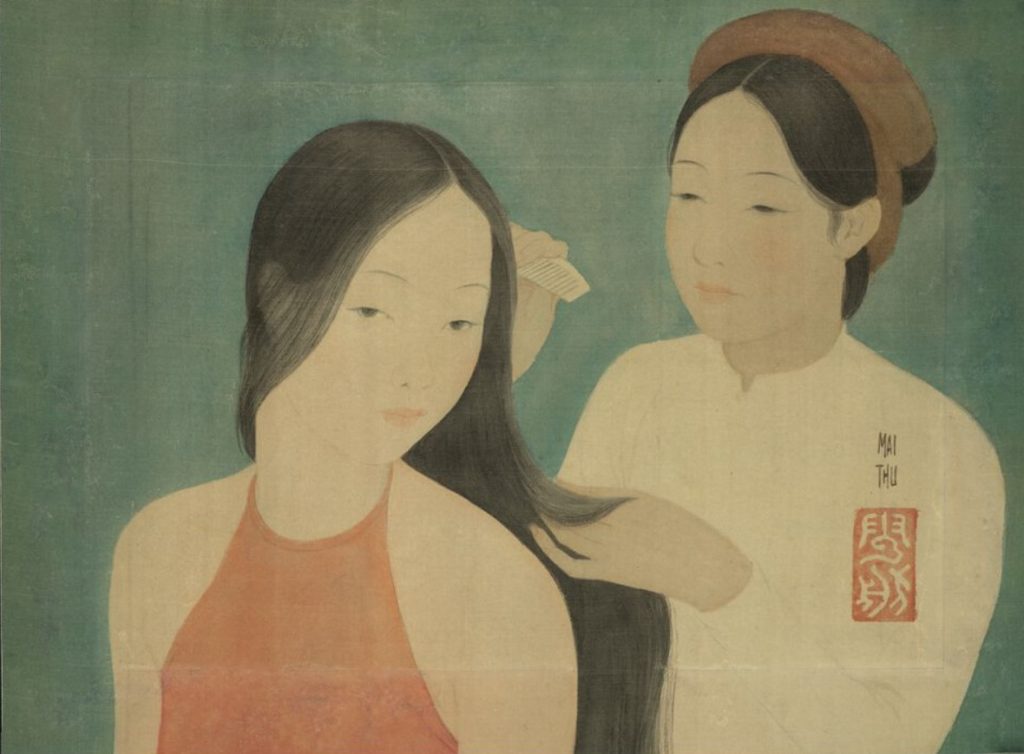Mai Thu, « La Coiffure » circa 1939, or the “sailing cloud”
“La coiffure” is an enchanting painting by a passionate artist.
A major work with an extremely rare stamp and a prestigious provenance, it tells us a great deal about the painter and his milieu.

A passionate painter.
When Mai Thu painted this picture, he was 33 and living in Paris at 32 rue Berthillon in the 15th arrondissement. His immediate neighbours were… Le Pho and Vu Cao Dam. One can imagine the emulation that guides these young artists, newcomers to pre-war Paris, this paradise of the arts. It was a paradise they were part of. A place Mai Thu was passionate about.
Since his arrival in 1937, he was part of a group exhibition at the La Muette’s art gallery, then at AGINDO (Agence Economique de l’Indochine), both in 1938. In 1939, he exhibited at the Salon des Indépendants, again at AGINDO and then at the Salon des Tuileries. A real visibility for the artist and an astonishing confrontation with the quasi-planetary elite of artists expressing themselves in Paris.
It’s easy to understand the creative energy behind our work. And its effect: a captivating charm.
A captivating charm.
In their gentle intimacy, dominated by a soft beauty, these two women are captivating.
The painter concentrates on the essential: no background other than a gradation of light green, no furniture or landscape. Nothing distracts us from the subject of the work. The light tones of the oval faces, the bare shoulders of one and the tunic of the other give the work structure. Pastel colors respond in pairs: the orange of the bustier and headdress and the inky blacks of the hair.
Two glances, one gazing into the distance, the other focused on the task at hand.
The stroke of the comb is extremely gentle, respecting the delicacy of the hair that conceals the lady’s ear. The artist expresses it in undulating waves, enhanced by the women’s semi-profile positions. Without the hieratic representation of the model that Mai Thu would later cultivate.
“La coiffure” is also a major work, thanks to its extremely rare stamp and prestigious provenance. Both tell us a great deal about the painter and his milieu.
The seal, a means of assertion, but which one?
In addition to the painter’s classic signature, the work bears an extremely rare seal, red and massive, almost ostentatious, as if it was part of the lady’s white tunic.
Our seal reads, in Vietnamese, Vân Phảng, which can be translated as “sailing cloud” (Vân = cloud, Phảng = sailing).
Subject to inventory, this stamp has only been identified in two other works by the painter, reproduced in the catalog of the exhibition devoted to the painter at the Musée des Ursulines in Macon (France) Mai Thu 1906-1980 écho d’un Vietnam rêvé (2021).
They are respectively titled La joueuse de flûte traversière, (The flûte-player – dated “circa 1940”, smaller size (22 X 19 cm)) and Coup de vent (Gust of wind – dated “circa 1939”, larger size (56 X 26cm)).
The former has exactly the same stamp and signature, and its background is comparable.
On the second, in addition to the Vân Phảng stamp and the same signature, we can identify another stamp: “Mai Thu Dai Nam” (Mai Thu Great South) and a signature “Mai Thu” in Chinese. The study (Indian ink on tracing paper) for Coup de vent (fig 9 p 24), also dated “circa 1940”, does not feature the above-mentioned stamps, but another (phóng đại quang minh) that can be translated as “radiant and correct magnification”.
As we know, the seal, which originated in Chinese tradition, expresses the name of a person or organization, but can also, among other things, evoke a symbolic setting, a poem or a saying…. Stamps are also part of calligraphy, with very similar aesthetic principles. Handling the engraving knife, expressing the “page” layout in the space of the seal, balancing and arranging the characters, choosing the style – all this is part of an eminently artistic process. A seal engraver is also an artist, and some painters, calligraphers and writers are also skilled engravers, such as Qi Baishi (1863-1957). Just like painting, music, chess and poetry, stamp engraving is one of the refined pleasures that a man of impeccable taste should enjoy.
So it’s no surprise if Mai Thu, the refined, the literate, the exceptional musician, devoted himself to this art.
And that, symbolically and poetically, Mai Thu identified and embodied himself as a “sailing cloud”. Free, in the Paris sky, in the wind of freedom and the desire that befits all creation.
A prestigious and significant provenance.
Our work belonged to Raymond Escholier (1882-1971), a French journalist, writer and art critic who lived an exceptionally rich life, worthy of a lengthy essay. Let us mention here that, from 1933 onwards, he was the Director of the Musée du Petit Palais in Paris, and in the years preceding “La coiffure”, two major exhibitions took place under his direct authority: « Art Italien » (from Cimabue to Tieopolo) in 1935, and two years later “Les Maîtres de l’Art Indépendant, 1895-1937“, where he exhibited the greatest contemporary artists, including Matisse, Bonnard, Soutine and Picasso.
Escholier’s interest in Mai Thu meant a great deal. It showed the immediate support of Parisian administrative and artistic circles for artists newly arrived from Vietnam.
Around 1939, Mai Thu, the “sailing cloud”, flew over the “city of light” on the whims of history.
Leaving his homeland to reach the sky.
Like a challenge
A successful one.
Jean-François Hubert
[…] 238 (Mai Thu / Hairdressing), lot 239 (Luong Xuan Nhi / Peach Blossom Market) and lot 252 (Mai Thu / Mother and Children) were […]